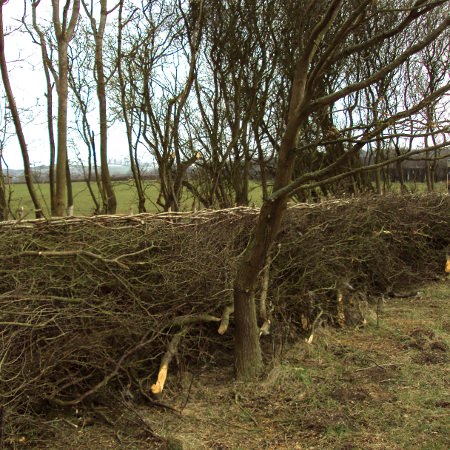Practical techniques: Hedgerows
England and Wales
Hedgerows have been used for centuries as boundaries and to provide barriers and screens. As well as this, they provide food and shelter for a variety of wildlife and have far more landscape value than a plain fence. Some hedgerows have been in existence for hundreds of years.
Protection and its implications
The Habitats Regulations stipulate the inclusion of policies in local authority planning documents that encourage the management of features of the landscape that are of major importance for wild flora and fauna. Examples include traditional field boundary systems such as hedgerows. The local planning authority should therefore have policies within its planning documents protecting hedgerows and may impose planning conditions and obligations relating to the protection of hedgerows on development sites.
Hedgerow is a priority habitat, listed as a Habitat of Principal Importance in England under Sections 41 of the NERC Act 2006, section 7 of the Environment Wales Act 2016, section 2 of the Nature Conservation (Scotland) Act 2004 and Section 3 of the Wildlife and Natural Environment Act (Northern Ireland) 2011. Government policy is that the local planning authority should consider such habitat when determining planning applications. A priority hedgerow is broadly defined as any boundary line of trees or shrubs consisting predominantly of at least one woody native species, being over 20m long and less than 5m wide, and where any gaps between the trees or shrubs are under 20m wide.
Some hedgerows are more formally protected by The Hedgerow Regulations 1997. These Regulations contain a complex system for determining whether a hedgerow should be considered important and protected from removal. The Regulations apply when undertaking most types of permitted development under the Town and Country Planning General Permitted Development Order 1995. The planning authority may also use these criteria to assess the environmental impacts of a proposed development that requires planning permission and to determine whether hedgerows should be retained within the development as a planning condition. However, the Regulations do not apply once planning permission has been granted.
Mitigation techniques
Since hedgerows may have taken many centuries to develop their current value, the retention of these features within the development is the most desirable option.
Where this is not practicable, there are two options to compensate for the loss of a hedgerow. One is to translocate the hedgerow to an alternative part of the development site. The second and more conventional option is to destroy the hedgerow and replant a hedgerow comprising similar species elsewhere within the development site. The best approach may depend on the age and diversity of the hedgerow with translocation being more suitable for particularly valuable hedgerows which cannot be maintained in situ.

When planting new hedgerows, it is important that the number and type of species planted are similar to other hedgerows locally. The layout of new hedgerows may also be important; ideally they should connect with existing hedgerows or woodland as this may help the movement of some species of wildlife. Once the development is complete, the way in which the hedgerow is managed will determine its value for wildlife and this should be considered in the overall design of the development.
Timing of works
Trimming of hedgerows should ideally be carried out in autumn or late winter (January and February) on a 2 or 3 year cycle. This avoids the bird nesting season and encourages thick growth and the production of a good flower and berry crop which provides food for wildlife. The best time to plant new hedgerows is between October and March (but not during freezing conditions). Autumn is a good time as the ground may still be wet and warm.
Further reading
Brooks A and Agate E (1998). Hedging: a practical handbook. British Trust for Conservation Volunteers, Doncaster.
Department for Environment, Food and Rural Affairs (2002). The Hedgerows Regulations 1997. A Guide to the Law and Good Practice. Department for Environment, Food and Rural Affairs, London.
The Heritage Council (2002) Conserving Hedgerows, Heritage Council, Kilkenny
Natural England (2015) Ancient woodland and veteran trees: protecting them from development. https://www.gov.uk/guidance/ancient-woodland-and-veteran-trees-protection-surveys-licences